
So we found a tour agency that got a big tick from the Lonely Planet and were told that they were different from other companies as their guides were university educated English speakers with outstanding local knowledge. This was all very well, if of course you know who and where your guide is. We sat on our tour boat enjoying the pan pipe show looking around for someone who looked university educated and English speaking with outstanding local knowledge. But no one on the boat fitted that description.
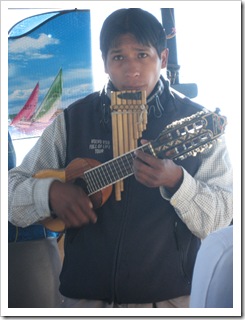
Our guide finally materialised when we arrived half an hour later at the first floating island. He showed us where we were on the map and described how the islands were made and what they were used for. There is some conjecture as to the original purpose of these islands but ultimately they provided a safe haven from savage mainlanders - such as the Incas or the Spanish.
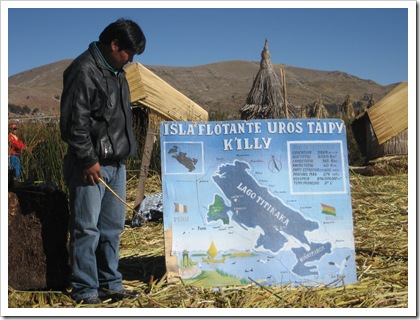
It was a little easier to describe the making of the islands with a demonstration. Below you can see one of the locals had built a replica of the island, complete with little figurines and houses.
First you need to find a big clump of floating reeds. These are normally attached to the river bed but in time the wind dislodges them. Then, take a huge quantity of cut reeds and place on top. If you can walk on it without falling into a hole and drowning, you have successfully made a floating island. By the way, walking on the island feels a bit like walking on a water bed.
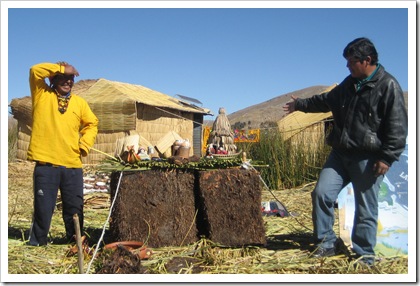
Once you make your island, then you should make a boat or two. And the good news is, the boats are also made out of totora. Beware, just because you put scary faces on the boats, doesn't mean tourists will stay away.
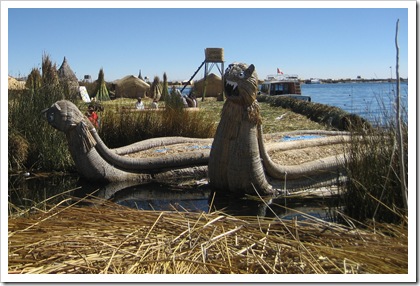
So you plan to live on the island? Well you will need a house. And guess what? You can use the same reed to build it! Totora can also be used for cooking fuel and treatment of minor ailments. Best of all, you can even eat it! Well only the heart of it anyway. Now for the bad news. After three or four months, the reeds start to rot and loose their bounce-factor. So you need to get in your boat and go find more reeds to replace the rotting ones.
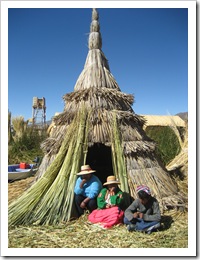
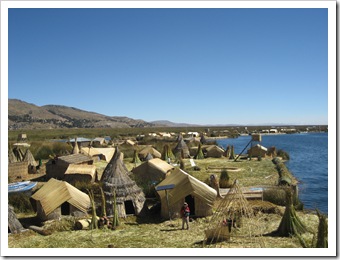
If you insist on still being connected to the real world, then you can even have your own TV.
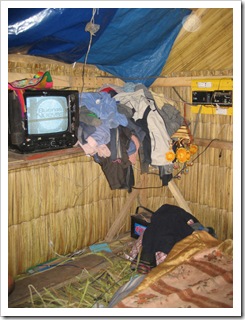
When the islanders aren't doing domestic chores, they are making products to sell to tourists. They make various weavings depicting events from their daily lives. We are now proud owners of some of their works.
Twenty years ago, a newly married couple would have built themselves an island, naming it after themselves. Now settlements are larger and many of the little islands have been abandoned and left to rot.
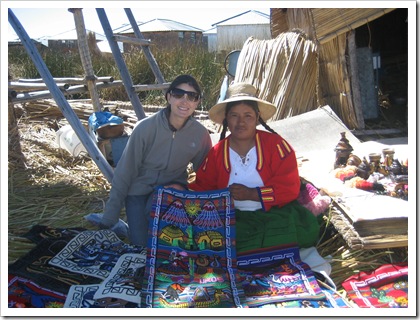
We farewelled our colourful islander friends and headed to another floating island to indulge in more shopping.
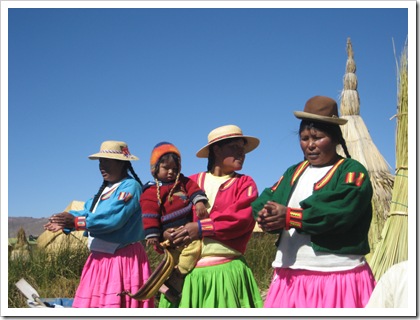
We hopped on the boat hungry and ready for lunch. We were told that we would have lunch when we reached Amantani Island. What we weren't told was that this island was still another two hours away.
Amantani is home to about 3600 Quechua speaking people - so our Spanish would be of no use here. The island is free from modern day conveniences like electricity or cars. It was on this island that we would stay the night. On arrival a tribe of mums arrived to greet us. Each ready to take a small group of gringos into their homes. We were supposed to bring a gift like fresh fruit or rice but do you think our guide told us this? No.
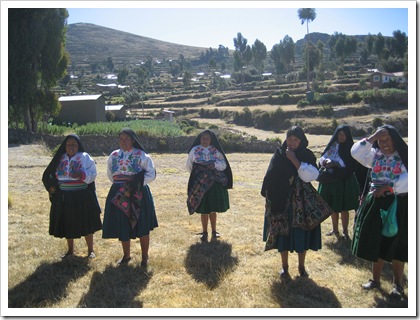
We carefully followed our mum back to her house making sure we never took her eye off her as all mums on the island look the same from behind!
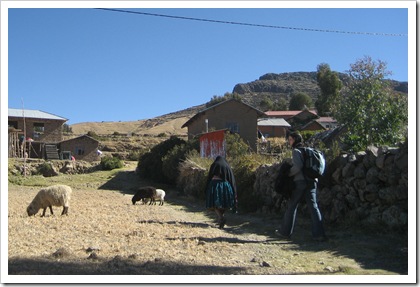
Her home was quite far from the shore. She shuffled in her well-worn sandals over rocks and hills, through farms and alleys until we reached her home.
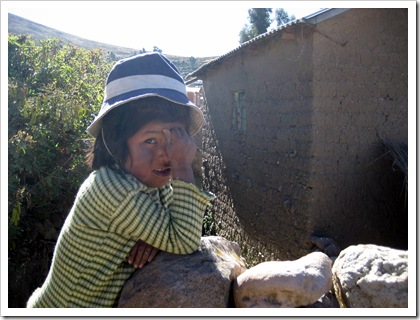
While we settled into our new room, our mum prepared lunch for us. We could not believe her kitchen. She had no electricity, no cupboards and no tables to prepare the food on. We marvelled as this little old lady slowly moved around her smokey kitchen constantly bending down to pick things up.
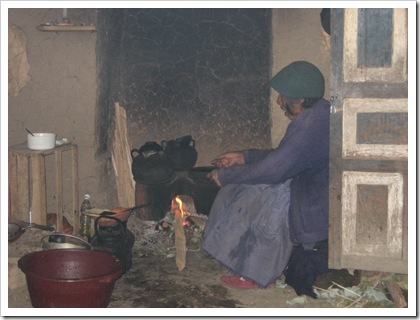
Finally our lunch was ready.
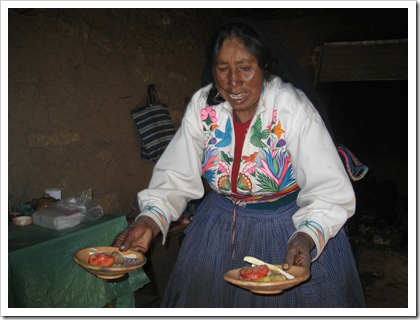
Lunch was a tomato, a piece of cheese and various incarnations of potato. Although very tasty, somehow we were more hungry after eating than before.
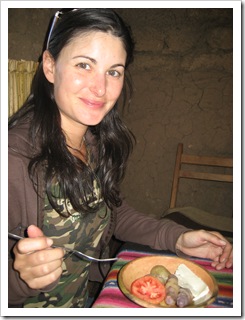
After lunch, we climbed up a hill called pachmama (mother nature) to see some pre-Incan ruins. When we arrived at the top, we could take a walk around the ruins 7 times to bring us luck. And as luck would have it by the time we were done, we could watch a beautiful sunset.
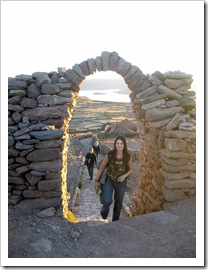
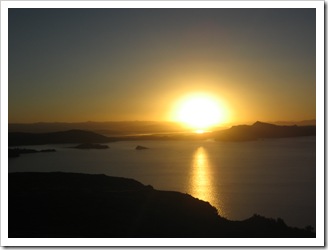
That night we were in for a big surprise. Our mum came up to our room with a big bag overflowing with traditional clothes for us to wear. She dressed TZ in layers upon layers of big colourful skirts, a white shirt, a belt and the customary black scarf. Jez was dressed more simply in a poncho. And finally to top it off, some interesting beanies - which we later bought for some extortionate amount.
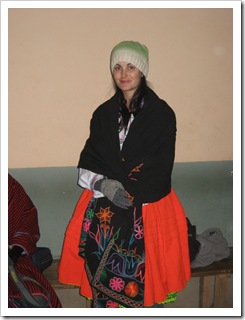
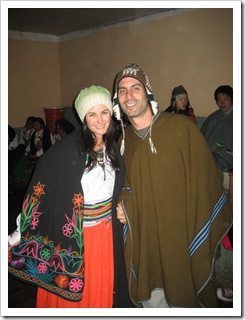
We walked silently and quickly in the cold night towards the dance hall. When we arrived we had a quick photo shoot.

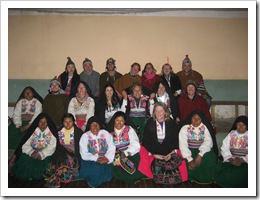
And then the festivities began. Panpipe music was played and our mums grabbed us and showed us some moves. It occurred to us that this kind of dancing was very similar to Israeli dancing. Big circles of people moving round and round the floor. People stepping on each others' feet. Never certain of when the circle will change direction or close in on itself. Click to see a video of TZ and our mum dancing.
The following day, we visited the Island of Taquile. This island was used as a prison when Peru was a Spanish Colony. Now this curiously dog-free island is inhabited by 3000 Taquiles.
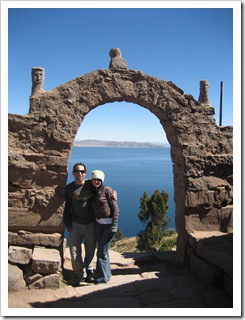
The Taquiles have a very interesting society. You can distinguish their status by the clothes they wear. Leaders wear black chullos (caps). Married men wear red ones and single men wear red and white ones. Women's status by contrast can be distinguished by the size of the pom poms on their skirts.
And now for a test: is this guy married, single or a leader?

There are 3 rules which govern the community. No lying, no cheating and don't be lazy. TZ wondered about these rules. She was concerned that there was no mention of murder or rape in the 3 commandments but on reflection perhaps there is sense behind it. Maybe the rules they have apply to transgressions which humans are more likely commit on a daily basis. Perhaps by focusing on these sins, a more honest society can be cultivated.
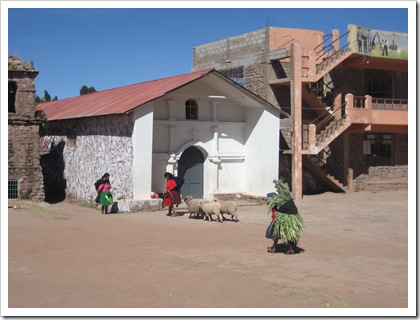
Sadly, we did not have time to see more of the islands in a less touristy fashion. Now fully acclimatised to the altitude, we could enjoy a few days in Cuzco before embarking on a pilgrimage to Machu Picchu - our final destination in South America.
While you wait for the next blog, we will leave you with this video of some naughty dogs we filmed from our hotel window.
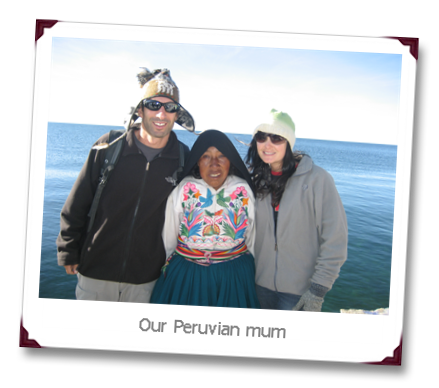

No comments:
Post a Comment